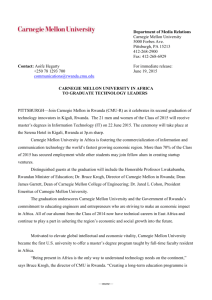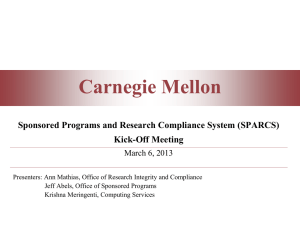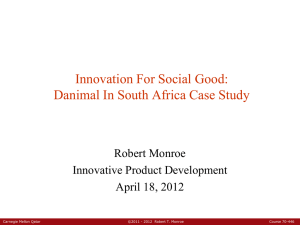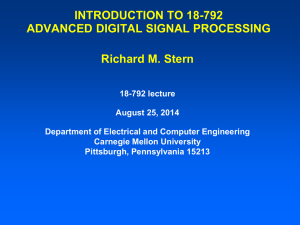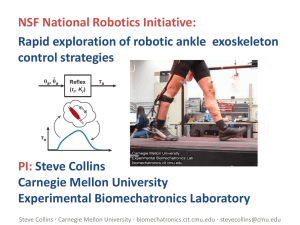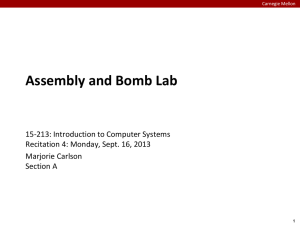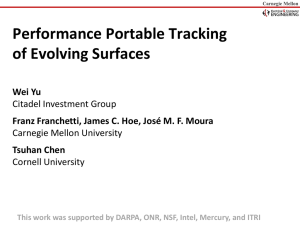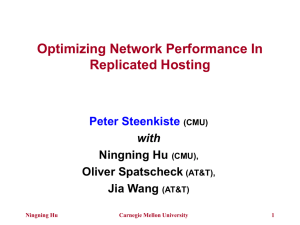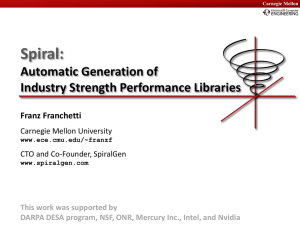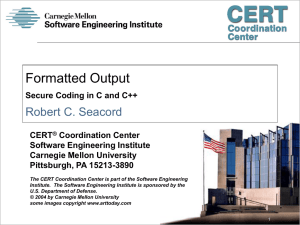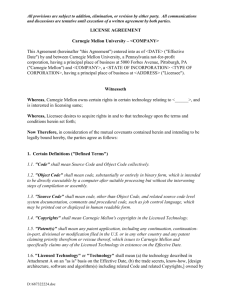QUELCE: Quantifying Uncertainty in Early Lifecycle Cost Estimation
advertisement
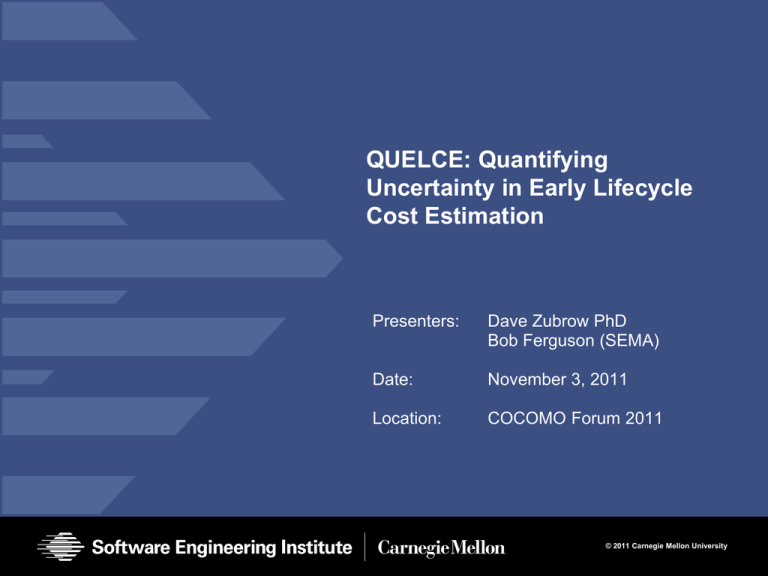
QUELCE: Quantifying
Uncertainty in Early Lifecycle
Cost Estimation
Presenters:
Dave Zubrow PhD
Bob Ferguson (SEMA)
Date:
November 3, 2011
Location:
COCOMO Forum 2011
© 2011 Carnegie Mellon University
DOD Acquisition Process and GAO KnowledgeBased Acquisition Practices
“Establishing realistic cost and schedule estimates that are
matched to available resources:
Cost and schedule estimates are often based on overly optimistic
assumptions. Our previous work shows that without the ability to
generate reliable cost estimates, programs are at risk of experiencing
cost overruns, missed deadlines, and performance shortfalls. Inaccurate
estimates do not provide the necessary foundation for sufficient funding
commitments. Engineering knowledge is required to achieve more
accurate, reliable cost estimates at the outset of a program.
Source: GAO 11-499T
© 2011 Carnegie Mellon University
2
DOD Acquisition Process and GAO KnowledgeBased Acquisition Practices
Source: GAO 11-499T
© 2011 Carnegie Mellon University
3
Estimating the Cost of Development at Milestone A
Challenges:
1) change and uncertainty
2) optimistic judgment
Acquisition Phases and Decision Milestones
Materiel
Solution
Technology
Development
A
Est. $
Cost Estimate
Based on:
• Limited Information
• Expert Judgment
• Analogies
Approval
B
Engineering
& Manufacturing
C
Est. $$
Production
& Deployment
Est. $$$
Y
N
Delay
© 2011 Carnegie Mellon University
4
QUELCE for Producing Milestone A Estimates
Brainstorm
Change Drivers
and Define States
Produce BBN
Model of
Reduced Matrix
Develop Cause
and Effect
Matrix of Change
Drivers
Rate Relationships,
Restructure and
Reduce using DSM
Assign Probabilities and
Conditional Probabilities
to Nodes in BBN
Map BBN Change
Factor Output States
to COCOMO Cost
Driver Values
Define Scenarios of
Program Execution
Use Monte Carlo to
Select Combinations
of BBN Outputs
to Produce Cost
Estimate Distributions
© 2011 Carnegie Mellon University
5
Change Drivers and States
Driver
Nominal
State 1
State 2
State 3
State 4
State 5
Stable
Users added
Additional (foreign)
customer
Additional deliverable
(e.g. training &
manuals)
Production
downsized
Scope Reduction
(funding reduction)
defined
New condition
New mission
New echelon
Program
becomes Joint
Stable
Addition
Subtraction
Variance
Trade-offs
[performance vs
affordaility, etc.]
Established
Funding delays tie up
resources {e.g.
operational test}
FFRDC ceiling issue
Funding change for
end of year
Funding spread
out
Obligated vs.
allocated funds
shifted
Stable
Joint service program
loses particpant
Senator did not get
re-elected
Change in senior
pentagon staff
Advocate
requires change
in mission scope
Service owner
different than
CONOPS users
Selected Trade
studies are
sufficient
Technology does not
achieve satisfactory
performance
Selected solution
Technology not
Technology is too
New technology not
cannot achieve desired performing as
expensive
testing well
outcome
expected
Scope Definition
Mission / CONOPS
Capability Definition
Funding Schedule
Advocacy Change
Closing Technical Gaps
(CBA)
Factors seeded by, but not limited to,
Probability of Program Success
(PoPS) factors.
© 2011 Carnegie Mellon University
6
ocol
f P rot
Com p
lexity
o
ompl
exity
Cost/
C
Test
Mono
lithic
Depe
nden
c
GUIWork
flow
ies
rovis
ionin
g
i on/P
Auto
-Dete
ct
Legac
y Cod
e
y
Comp
atibil
it
ards
Backw
Depe
nden
cies
Vend
or
izatio
n
Staff
Ski lls
et
Optim
Per fo
rman
ce
of De
pl oym
Diver
sity
User
rol Pl
ane
Cont
User
Driver Cross
Impact Matrix
Plane
ents
Cause and Effect Matrix for Change Drivers
User Plane
Control Plane
User
Diversity of Deployments
Performance Optimization
Staff Skillset
Vendor Dependencies
Backwards Compatibility
Legacy Code
Auto-Detection/Provisioning
GUI- Workflow
Monolithic Dependencies
Test Cost/Complexity
Complexity of Protocol
Each cell gets a value (blank, 1, 2, or 3) to reflect the perceived cause-effect
relationship of the row heading to the column heading)
Note: The sum of a column represents a dependency score for the column header.
The sum of a row is the value of the driving force of the row header
© 2011 Carnegie Mellon University
7
Reduced Cause and Effect Matrix
1
1
1
2
2
1
2
2
1
1
2
1
2
2
2
0
1
1
1
0
1
1
1
1
1
1
1
1
1
1
1
1
2
1
1
1
1
2
1
1
2
1
2
2
1
1
1
1
1
1
1
2
2
1
2
2
2
1
1
1
1
2
1
1
2
2
2
0
2
1
1
1
1
1
1
1
1
1
2
1
1
1
1
1
1
2
2
2
2
2
3
1
2
1
2
1
1
1
1
1
1
1
1
1
1
1
1
2
1
1
3
2
1
1
1
1
1
1
2
2
2
2
Indicates remaining cycle that must be removed
2
0
0
6
0
4
1
1
1
9
4
5
4
12
4
8
1
7
2
7
0
13
3
4
1
10
3
15
2
18
2
7
3
7
1
8
0
8
1
14
0
17
0
17
0
15
0
12
0
9
0
10
0
13
0
11
0
20
0
19
0
5
0
5
0
6
29
16
6
34
27
29
21
33
16
5
10
5
19
12
14
6
5
6
10
7
7
4
0
0
2
2
0
0
0
2
0
0
0
17
0
Use Design Structure Matrix techniques to reduce so an acyclic graph can be produced.
© 2011 Carnegie Mellon University
8
Number right of diagonal
1
1
3
3
1
2
0
1
3
2
1
0
Total
2
1
1
2
1
Product Challenge
2
2
Project Challenge
2
Size
1
1
3
Contractor Performance
2
2
2
3
1
1
1
2
2
2
1
2
Data Ownership
Standards/Certifications
1
1
1
0
3
2
Test & Evaluation
2
1
1
1
1
1
1
1
3
1
1
1
1
2
0
Cost Estimate
2
2
1
2
1
2
1
1
1
2
2
2
1
2
1
2
1
Industry Company Assessment
1
2
1
Production Quantity
1
2
2
2
Contract Award
2
1
Sustainment Issues
2
2
2
1
1
1
2
PO Process Performance
1
1
1
3
Information sharing
2
0
2
1
2
2
0
2
3
2
Supply Chain Vulnerabilities
3
3
Scope Responsibility
Manning at program office
Prog Mgt Structure
Project Social / Dev Env
Program Mgt - Contractor Relations
Acquisition Management
Funding Schedule
Functional Solution Criteria (measure)
Scope Definition
Functional Measures
Interdependency
Systems Design
3
Interoperability
Advocacy Change
3
3
Closing Technical Gaps (CBA)
Capability Definition
Mission / CONOPS
Change in Strategic Vision
Capability Definition
Advocacy Change
Closing Technical Gaps (CBA)
Building Technical Capability & Capacity (CBA)
Interoperability
Systems Design
Interdependency
Functional Measures
Scope Definition
Functional Solution Criteria (measure)
Funding Schedule
Acquisition Management
Program Mgt - Contractor Relations
Project Social / Dev Env
Prog Mgt Structure
Manning at program office
Scope Responsibility
Standards/Certifications
Supply Chain Vulnerabilities
Information sharing
PO Process Performance
Sustainment Issues
Contract Award
Production Quantity
Data Ownership
Industry Company Assessment
Cost Estimate
Test & Evaluation
Contractor Performance
Size
Project Challenge
Product Challenge
Totals
0
Below diagonal
0
Change in Strategic Vision
Causes
Mission / CONOPS
Effects
Building Technical Capability & Capacity (CBA)
Change Drivers - Cause & Effects Matrix
0
0
0
0
0
0
1
3
5
0
0
1
0
2
2
2
1
2
5
2
4
3
0
0
0
0
0
0
0
0
0
0
0
0
0
BBN of Reduced Cause and Effect Matrix
Translate the C-E Matrix
into a BBN.
Orange nodes are
program change factors.
Green nodes are outputs
that will link to COCOMO
cost drivers.
These output nodes were
selected as an example
and represent sets of
COCOMO cost drivers.
© 2011 Carnegie Mellon University
9
Assign Probabilities and Conditional
Probabilities to BBN Nodes
Use expert judgment to
assign probabilities and
conditional probabilities
to the nodes.
These assignments
could also be empirically
based if the data are
available.
Capability Definition
is affected by
CONOPS and
Strategic Vision
© 2011 Carnegie Mellon University
10
Define Scenarios of Program Execution
Scenarios for alternate futures specify nominal or non-nominal states for selected
change drivers to test alternative results.
© 2011 Carnegie Mellon University
11
Map BBN Change Factor Output States to
COCOMO Cost Driver Values
Drivers
XL
VL
L
6.20
5.07
7.07
5.48
7.80
4.96
4.05
5.65
4.38
6.24
0.49
0.60
2.12
1.59
1.43
1.62
1.33
1.30
1.43
0.83
0.95
0.87
1.26
1.12
1.10
1.14
PREC
FLEX
RESL
TEAM
PMAT
RCPX
RUSE
PDIF
PERS
PREX
FCIL
SCED
N
H
VH
Scale Factors
3.72 2.48 1.24
3.04 2.03 1.01
4.24 2.83 1.41
3.29 2.19 1.10
4.68 3.12 1.56
Effort Multipliers
1.00 1.33 1.91
1.00 1.07 1.15
1.00 1.29 1.81
1.00 0.83 0.63
1.00 0.87 0.74
1.00 0.87 0.73
1.00 1.00 1.00
XH
Product Project
0.00
0.00
0.00
0.00
0.00
<X>
<X>
<X>
2.72
1.24
2.61
0.50
0.62
0.62
X
X
X
<X>
<X>
<X>
<X>
<X>
<X>
BBN output states are mapped to values of COCOMO cost drivers.
Currently done with expert judgment. Later could be done using a data-based
algorithm.
Distributions of BBN outputs used in next step.
© 2011 Carnegie Mellon University
12
Use Monte Carlo to Select Combinations of BBN
Outputs to Produce Cost Estimate Distributions
4
BBN Outputs
4
Mapped
COCOMO
value
Using distribution of BBN outputs, Monte Carlo simulation is used to produce the
distribution of the cost estimation for each defined scenario.
© 2011 Carnegie Mellon University
13
Task 2: Develop Efficient Techniques To Calibrate
Expert Judgment of Program Uncertainties
Solution
Step 2: Expert
takes series of
domain specific
tests
Step 3: Expert reduces
overconfidence
Step 1: Expert
virtual training
of “reference
points”
Step 4: Expert
renders calibrated
estimate of size
Domain-Specific
“reference points”
1)
Size of ground combat vehicle
targeting feature xyz in 2002
consisted of 25 KSLOC Ada
2)
Size of Army artillery firing
capability feature abc in 2007
consisted of 18 KSLOC C++
3)
…
Un-Calibrated
Calibrated
Calibrated = more
realistic size and
wider range to
reflect true expert
uncertainty
Estimate of SW Size
© 2011 Carnegie Mellon University
14
Next Steps
Classroom experiments with software & systems engineering graduate
students
• Structured feedback for early validation & refinement of our method, initially:
– Selected steps at least through reducing the client’s dependency matrix at the
University of Arizona
– Calibrating expert judgment & reconciliation of differences in judgment at Carnegie
Mellon University
Invitation to Participate
• Many pieces and parts to test and improve
• Empirically validating the overall approach
– Retrospective: projects that were estimated and have recorded change history
• Testing BBN output parameters and mapping to estimation parameters
• Fitting to additional estimation tools and cost estimation relationships (CER)
• Do new estimates properly inform decisions about risk and
change management? (secondary benefit)
© 2011 Carnegie Mellon University
15
Contact Information
Presenters/ Points of Contact
Dave Zubrow
SEMA
Telephone: +1 412-268-5243
Email: dz@sei.cmu.edu
Bob Ferguson
SEMA
Telephone: +1 412-268-9750
Email: rwf@sei.cmu.edu
Web:
www.sei.cmu.edu
www.sei.cmu.edu/measurement/
U.S. mail:
Software Engineering Institute
Customer Relations
4500 Fifth Avenue
Pittsburgh, PA 15213-2612
USA
Customer Relations
Email: info@sei.cmu.edu
Telephone:
+1 412-268-5800
SEI Phone:
+1 412-268-5800
SEI Fax:
+1 412-268-6257
© 2011 Carnegie Mellon University
16
NO WARRANTY
THIS CARNEGIE MELLON UNIVERSITY AND SOFTWARE ENGINEERING INSTITUTE
MATERIAL IS FURNISHED ON AN “AS-IS" BASIS. CARNEGIE MELLON UNIVERSITY
MAKES NO WARRANTIES OF ANY KIND, EITHER EXPRESSED OR IMPLIED, AS TO
ANY MATTER INCLUDING, BUT NOT LIMITED TO, WARRANTY OF FITNESS FOR
PURPOSE OR MERCHANTABILITY, EXCLUSIVITY, OR RESULTS OBTAINED FROM
USE OF THE MATERIAL. CARNEGIE MELLON UNIVERSITY DOES NOT MAKE ANY
WARRANTY OF ANY KIND WITH RESPECT TO FREEDOM FROM PATENT,
TRADEMARK, OR COPYRIGHT INFRINGEMENT.
Use of any trademarks in this presentation is not intended in any way to infringe on the
rights of the trademark holder.
This Presentation may be reproduced in its entirety, without modification, and freely
distributed in written or electronic form without requesting formal permission. Permission
is required for any other use. Requests for permission should be directed to the Software
Engineering Institute at permission@sei.cmu.edu.
This work was created in the performance of Federal Government Contract Number
FA8721-05-C-0003 with Carnegie Mellon University for the operation of the Software
Engineering Institute, a federally funded research and development center. The
Government of the United States has a royalty-free government-purpose license to use,
duplicate, or disclose the work, in whole or in part and in any manner, and to have or
permit others to do so, for government purposes pursuant to the copyright license under
the clause at 252.227-7013.
© 2011 Carnegie Mellon University
17

